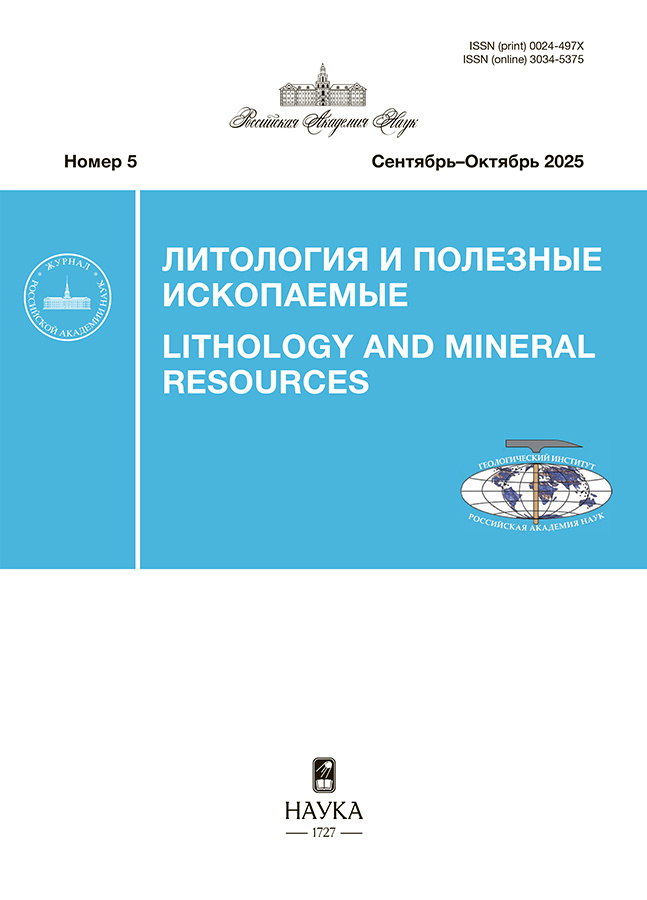№ 3 (2023)
Статьи
Структурно-кристаллохимические особенности смешанослойных иллит-содержащих минералов из катагенетически измененных верхнеюрских нефтематеринских пород
Аннотация
Иллит-смектитовые (I-S) минералы из верхнеюрских нефтеносных сланцев Дании и Северного моря были исследованы комплексом дифракционных и спектроскопических методов. Детальные структуры были определены для выявления механизма постседиментационной трансформации этих сланцев. Обычно в нефтеносных породах осадочных бассейнов генерация нефти происходит одновременно с диа- и катагенетической трансформацией I-S. Полученные результаты демонстрируют связь между этими двумя реакциями: молекулы NH3, освобождаемые из керогена во время максимального нефтеобразования, фиксируются как катионы аммония NH4 в смектитовых или вермикулитовых межслоях, образуя структурные фрагменты слюды или тобелита. В результате этого твердофазового преобразования формируются смешанослойные структуры, состоящие из слоев иллита, тобелита, смектита и вермикулита (I-T-S-V).
 215-229
215-229


Состав и генезис карбонатных стяжений района Парамуширских гидроакустических аномалий (Охотское море)
Аннотация
Карбонатные стяжения из района Парамуширских гидроакустических аномалий территориально приурочены к зонам выходов метановых сипов, контролируемых, в свою очередь, глубинными тектонически ослабленными участками дна. По структуре, химическому и минеральному составу стяжения можно классифицировать, как вулканогенно-осадочную породу, состоящую из витро-, лито-, кристаллокластов и захороненной микрофауны, сцементированных карбонатным (арагонитовым) цементом. Рассматриваются детали и последовательность минералообразования карбонатных стяжений.
 230-248
230-248


Индексы химического выветривания и их использование для палеоклиматических реконструкций (на примере разреза венда‒нижнего кембрия Подольского Приднестровья)
Аннотация
В статье представлен обзор различных индексов/индикаторов (индексы Фогта, Паркера, ГМ, SA, CIA, CIW, PIA, MIA и др.), используемых при исследовании профилей/кор выветривания и реконструкции палеоклиматических обстановок накопления осадочных последовательностей. Возможности их продемонстрированы на примере терригенных отложений венда‒нижнего кембрия Подольского Приднестровья (юго-западный склон Украинского щита). Распределение значений индекса ba1 в данном разрезе указывает на присутствие наиболее преобразованного процессами химического выветривания материала в составе аргиллитов нагорянской, нижней части даниловской и средней части студеницкой свит. Для аргиллитов даниловско-збручского интервала значения ГМ близки к ГМPAAS. Для пород ярышевско-нагорянского интервала значения ГМ несколько выше, а для аргиллитов нижней части ярышевской свиты, сопоставимы с теми, что свойственны континентальным глинам жаркого тропического климата. Среднее значение индекса SA для аргиллитов всего разреза равно 5.6 ± 0.7. Аргиллиты грушкинско-нагорянского интервала, где SA < SAPAAS, сложены более выветрелым материалом. Величины WIP в аргиллитах могилевской и ярышевской свит, а также верхов збручской свиты, отвечают интервалу их значений между PAAS и средним архейским гранитом. Глинистые породы других свит имеют значения WIP ≤ WIPPAAS. Величина CIAсреднее для аргиллитов равна 71 ± 4, что практически соответствует ее значению (70), разделяющему отложения холодного/аридного и теплого/гумидного климата. Вариации индекса CIW по разрезу симбатны вариациям CIA. Подавляющее большинство аргиллитов характеризуется значениями PIA > PIAPAAS. Величина CPAсреднее (91 ± 4) принципиально не отличается от той, что характерна PAAS. Приведенные и другие данные показывают, что на основе интерпретации свойственных тонкозернистым обломочным породам значений различных индексов химического выветривания, палеоклимат, существовавший в венде‒раннем кембрии на территории Подольского Приднестровья, может рассматриваться как умеренный или теплый гумидный. Сопоставление свойственных аргиллитам величин CIA с их значениями в тонкой взвеси современных рек дает основание предполагать, что климат венда и раннего кембрия напоминал современные сухой и гумидный субтропический или сухой тропический с элементами гумидного.
 249-273
249-273


Ранневендская положительная С-изотопная аномалия в известняках Чернореченской свиты Игарского поднятия (северо-запад Сибирской платформы)
Аннотация
В карбонатных осадочных породах и в рассеянном органическом веществе чернореченской свиты докембрия Игарского поднятия установлена высокоамплитудная (до +12.4‰) положительная аномалия δ13С, охватывающая интервал разреза мощностью более 500 м. Вариации кривых δ13Скарб и δ13Сорг синхронны и не зависят от условий формирования известняков, которые накапливались в различных частях карбонатного рампа. Изотопный состав кислорода и иные геохимические критерии указывают на незначительное влияние постседиментационных изменений и хорошую сохранность изотопных систем. Исходя из вариаций содержаний малых элементов в карбонатной фракции, в стратотипическом разрезе чернореченской свиты чередуются интервалы, формировавшиеся в аноксических и в более оксигенных условиях, что также не влияло на изотопный состав углерода. Показано, что известняки, обнажающиеся на о. Плахинский и содержащие обильные текстуры molar-tooth, по своему химическому и изотопному составу также относятся к чернореченской свите. Вероятной причиной крупной положительной аномалии δ13С является глобальный дефицит изотопа 12С в палеоокеане из-за накопления метангидратов и захоронения неокисленной органики. Минимальные значения отношения 87Sr/86Sr для чернореченской свиты составляют 0.7074, что в сочетании с другими геохронологическими и стратиграфическими данными позволяет относить ее к нижнему эдиакарию/нижнему венду (635‒580 млн лет). Ближайшим стратиграфическим аналогом чернореченской свиты являются отложения дальнетайгинской серии Патомского района и сопоставляемые с ней толщи на юге Сибирской платформы, а глобальный характер установленной положительной аномалии δ13С позволяет коррелировать ее с одновозрастными С-изотопными событиями других регионов Мира.
 274-298
274-298


Новые данные о возрасте рудовмещающих отложений озерного полиметаллического месторождения (Западное Забайкалье)
Аннотация
Представлены результаты литологического, биостратиграфического и U-Pb геохронологического (детритовые цирконы) изучения вулканогенно-терригенной озерной пачки верхней подсвиты нижнепалеозойской олдындинской свиты, вмещающей колчеданно-полиметаллические руды Озерного месторождения (Курбино-Еравнинский рудный район, Западное Забайкалье). Изучены первый, второй и “кристаллотуфовый” продуктивные горизонты первого рудоносного уровня озерной пачки. Она представлена чередованием туфов, известковистых, кремнистых, углистых туффитов, пелитоморфных известняков, известняковых гравелитов с прослоями и линзами оруденелых туфоконглобрекчий и пластами полосчатых сидеритовых колчеданных руд. Впервые в известковистых туфоалевролитах и известняках второго и “кристаллотуфового” продуктивных горизонтов установлены мшанки, водоросли и палинофлора. Эти данные свидетельствуют о раннекаменноугольном, турнейском времени накопления отложений. Результаты U-Pb геохронологических исследований детритовых цирконов из оруденелой туфоконглобрекчии третьего продуктивного горизонта ограничивают нижний предел времени формирования пород как не древнее позднего кембрия.
 299-314
299-314


Правила для авторов
 315-316
315-316












